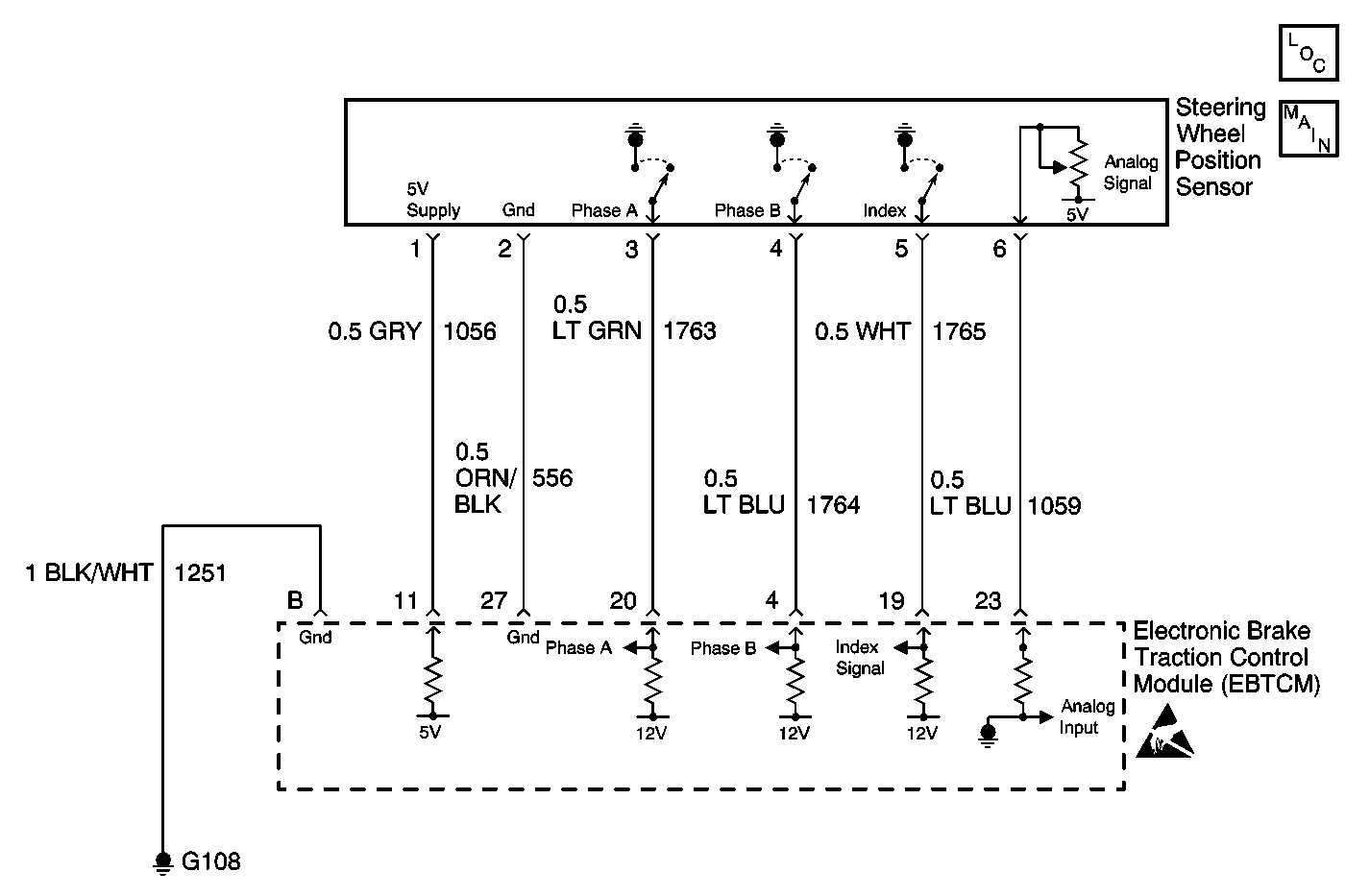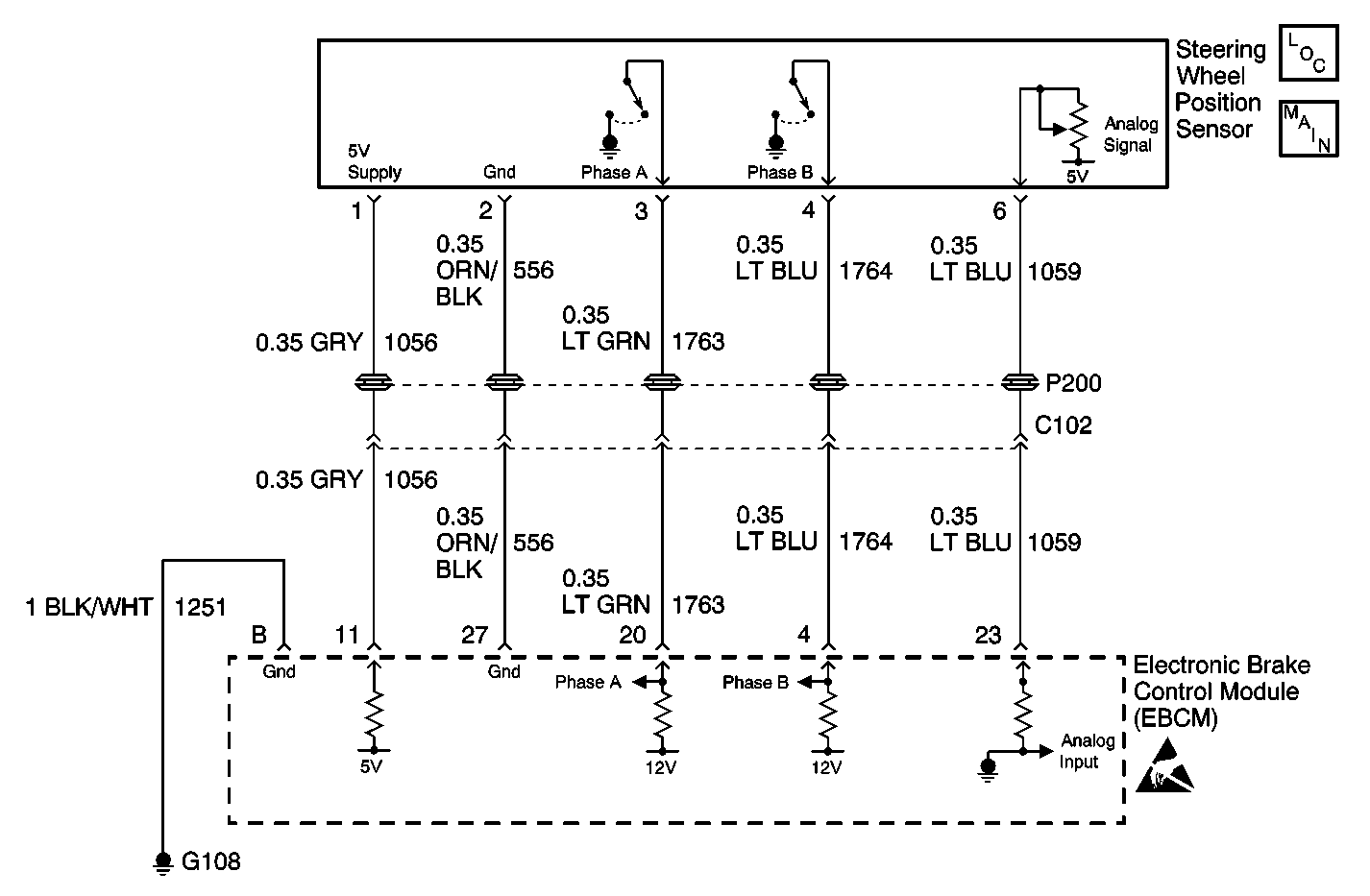DTC C1288 Steering Sensor Circuit Malfunction Without RPO JL4

Circuit Description
The Steering Wheel Position Sensor provides the EBCM with an analog voltage reading from 0.2-4.8 V depending on the steering wheel angle. The EBCM uses the analog voltage for the centering routine. The EBCM runs a centering routine when the vehicle speed goes above 30 km/h (18 mph). When the vehicle reaches 30 km/h (18 mph), the EBCM monitors the Steering Wheel Position Sensor inputs (Phase A, Phase B and Analog voltage) to see if the steering wheel is moving. If the steering wheel is not moving for a set period of time then the EBCM assumes the vehicle is going in a straight line. At this point, the EBCM looks at the analog voltage signal and reads the voltage. This voltage, normally around 2.5 V, is then considered the center position and the digital degrees also become zero at the same time. This centering routine is necessary to compensate for wear in the steering and suspension. Wear in the steering and suspension can result in a change in the relationship between the steering wheel and the front wheels. By running the centering routine, the EBCM can compensate for these changes by changing the digital and analog center position.
Conditions for Setting the DTC
The Steering Wheel Position Sensor analog output voltages falls outside 0.2-4.8 V range.
Action Taken When the DTC Sets
Magnasteer®2 is disabled, ABS/TCS remains active.
Messages displayed on the DIC:
Service Vehicle Soon
Diagnostic Aids
The following are possible causes:
| • | A Steering Wheel Position Sensor circuit open. |
| • | A Steering Wheel Position Sensor shorted. |
| • | Check connector C102 RH side rear of engine compartment for water intrusion or missing plugs, and that the connector is oriented horizontal to prevent water intrusion. |
Perform an inspection of the wiring and of the connectors. Failure to carefully inspect the wiring and the connectors may result in misdiagnosis. Misdiagnosis causes part replacement with reappearance of the malfunction.
Test Description
The numbers below refer to step numbers on the diagnostic table.
Step | Action | Value(s) | Yes | No |
|---|---|---|---|---|
1 | Was the Diagnostic System Check performed? | -- | ||
2 | Is this vehicle equipped with Active Handling (RPO JL4)? | -- | ||
3 |
Is the voltage within the range specified in the value(s) column? | 0.2-4.8 V | ||
4 |
Is the voltage within the range specified in the value(s) column? | 4.75-5.25 V | ||
5 | Using J 39200 DMM, measure the resistance between the Steering Wheel Position Sensor harness connector terminal 2 and a good ground. Is the resistance within the range specified in the value(s) column? | 0-5 ohms | ||
Using the J 39200 DMM, measure the voltage at terminal 6 of the Steering Wheel Position Sensor harness connector. Is the above within the value specified in the value(s) column? | 1 V | |||
7 | Repair CKT 1059 for a short to voltage. Refer to Wiring Repairs in Wiring Systems. Is the repair complete? | -- | -- | |
Is the resistance within the range specified within the value(s) column? | OL (infinite) | |||
9 | Repair CKT 1059 for a short to ground. Refer to Wiring Repairs in Wiring Systems. Is the repair complete? | -- | -- | |
Is the resistance within the range specified within the value(s) column? | 0-5 ohms | |||
11 | Repair CKT 1059 for an open. Refer to Wiring Repairs in Wiring Systems. Is the repair complete? | -- | -- | |
12 | Replace the EBCM. Refer to Electronic Brake Control Module Replacement . Is the replacement complete? | -- | -- | |
13 | Replace the Steering Wheel Position Sensor. Refer to Steering Shaft, Lower Bearing, and Jacket - Disassemble - Off Vehicle in Steering Wheel and Column. Is the replacement complete? | -- | -- | |
14 |
Is the resistance within the range specified within the value(s) column? | 0-5 ohms | ||
15 | Repair CKT 1056 for an open. Refer to Wiring Repairs in Wiring Systems. Is the repair complete? | -- | -- | |
16 |
Is the resistance within the range specified in the values column? | OL (infinite) | ||
17 | Repair CKT 1056 for a short to ground. Refer to Wiring Repairs in Wiring Systems. Is the repair complete? | -- | -- | |
18 | Repair CKT 556 for an open or high resistance. Refer to Wiring Repairs in Wiring Systems. Is the repair complete? | -- | -- |
DTC C1288 Steering Sensor Circuit Malfunction RPO JL4

Circuit Description
The Steering Wheel Position Sensor provides the EBCM with an analog voltage reading from 0.2-4.8 V depending on the steering wheel angle. The EBCM uses the analog voltage for the centering routine. The EBCM runs a centering routine when the vehicle speed goes above 10 km/h (6 mph). When the vehicle reaches 10 km/h (6 mph), the EBCM monitors the Steering Wheel Position Sensor inputs (Phase A, Phase B and Analog voltage) to see if the steering wheel is moving. If the steering wheel is not moving for a set period of time then the EBCM assumes the vehicle is going in a straight line. At this point, the EBCM looks at the analog voltage signal and reads the voltage. This voltage, normally around 2.5 V, is then considered the center position and the digital degrees also become zero at the same time. This centering routine is necessary to compensate for wear in the steering and suspension. Wear in the steering and suspension can result in a change in the relationship between the steering wheel and the front wheels. By running the centering routine, the EBCM can compensate for these changes by changing the digital and analog center position.
Conditions for Setting the DTC
The Steering Wheel Position Sensor analog output voltages falls outside 0.2-4.8 V range.
Action Taken When the DTC Sets
ABS and TCS remain enabled, Active Handling™ is disabled.
| • | Indicators that turn on: |
| Car Icon (TCS indicator) |
| • | Messages displayed on the DIC: |
| Service Active HNDLG |
| Service Vehicle Soon |
Diagnostic Aids
The following are possible causes:
| • | A Steering Wheel Position Sensor circuit open. |
| • | A Steering Wheel Position Sensor shorted. |
Perform an inspection of the wiring and of the connectors. Failure to carefully inspect the wiring and the connectors may result in misdiagnosis. Misdiagnosis causes part replacement with reappearance of the malfunction.
Test Description
The numbers below refer to step numbers on the diagnostic table.
Step | Action | Value(s) | Yes | No |
|---|---|---|---|---|
1 | Was the Diagnostic System Check performed? | -- | ||
2 | Is this vehicle equipped with Active Handling (RPO JL4)? | -- | ||
3 |
Is the voltage within the range specified in the value(s) column? | 0.2-4.8 V | ||
4 |
Is the voltage within the range specified in the value(s) column? | 4.74-5.25 V | ||
5 | Using J 39200 DMM, measure the resistance between the Steering Wheel Position Sensor harness connector terminal 2 and a good ground. Is the resistance within the range specified in the value(s) column? | 0-5 ohms | ||
Using the J 39200 DMM, measure the voltage at terminal 6 of the Steering Wheel Position Sensor harness connector. Is the voltage within the range specified in the value(s) column? | Above 1 V | |||
7 | Repair CKT 1059 for a short to voltage. Refer to Wiring Repairs in Wiring Systems. Is the repair complete? | -- | -- | |
Is the resistance within the range specified within the value(s) column? | OL (infinite) | |||
9 | Repair CKT 1059 for a short to ground. Refer to Wiring Repairs in Wiring Systems. Is the repair complete? | -- | -- | |
Is the resistance within the range specified within the value(s) column? | 0-5 ohms | |||
11 | Repair CKT 1059 for an open. Refer to Wiring Repairs in Wiring Systems. Is the repair complete? | -- | -- | |
12 | Replace the EBCM. Refer to Electronic Brake Control Module Replacement . Is the replacement complete? | -- | -- | |
13 | Replace the Steering Wheel Position Sensor. Refer to Steering Shaft, Lower Bearing, and Jacket - Disassemble - Off Vehicle in Steering Wheel and Column. Is the replacement complete? | -- | -- | |
14 |
Is the resistance within the range specified within the value(s) column? | 0-5ohms | ||
15 | Repair CKT 1056 for an open or high resistance. Refer to Wiring Repairs in Wiring Systems. Is the repair complete? | -- | -- | |
16 |
Is the resistance within the range specified in the values column? | OL (infinite) | ||
17 | Repair CKT 1056 for a short to ground. Refer to Wiring Repairs in Wiring Systems. Is the repair complete? | -- | -- | |
18 | Repair CKT 556 for an open or high resistance. Refer to Wiring Repairs in Wiring Systems. Is the repair complete? | -- | -- |
